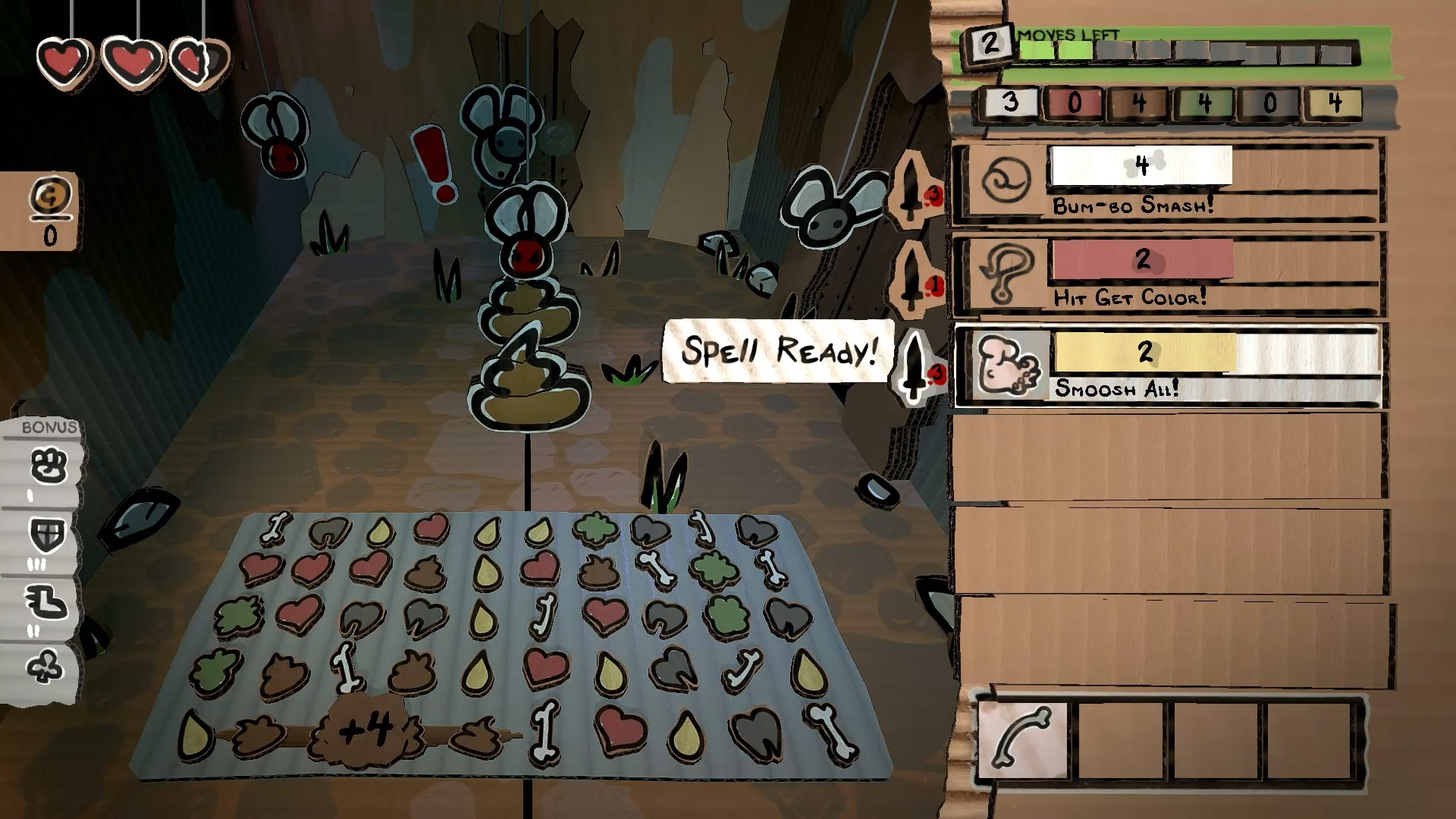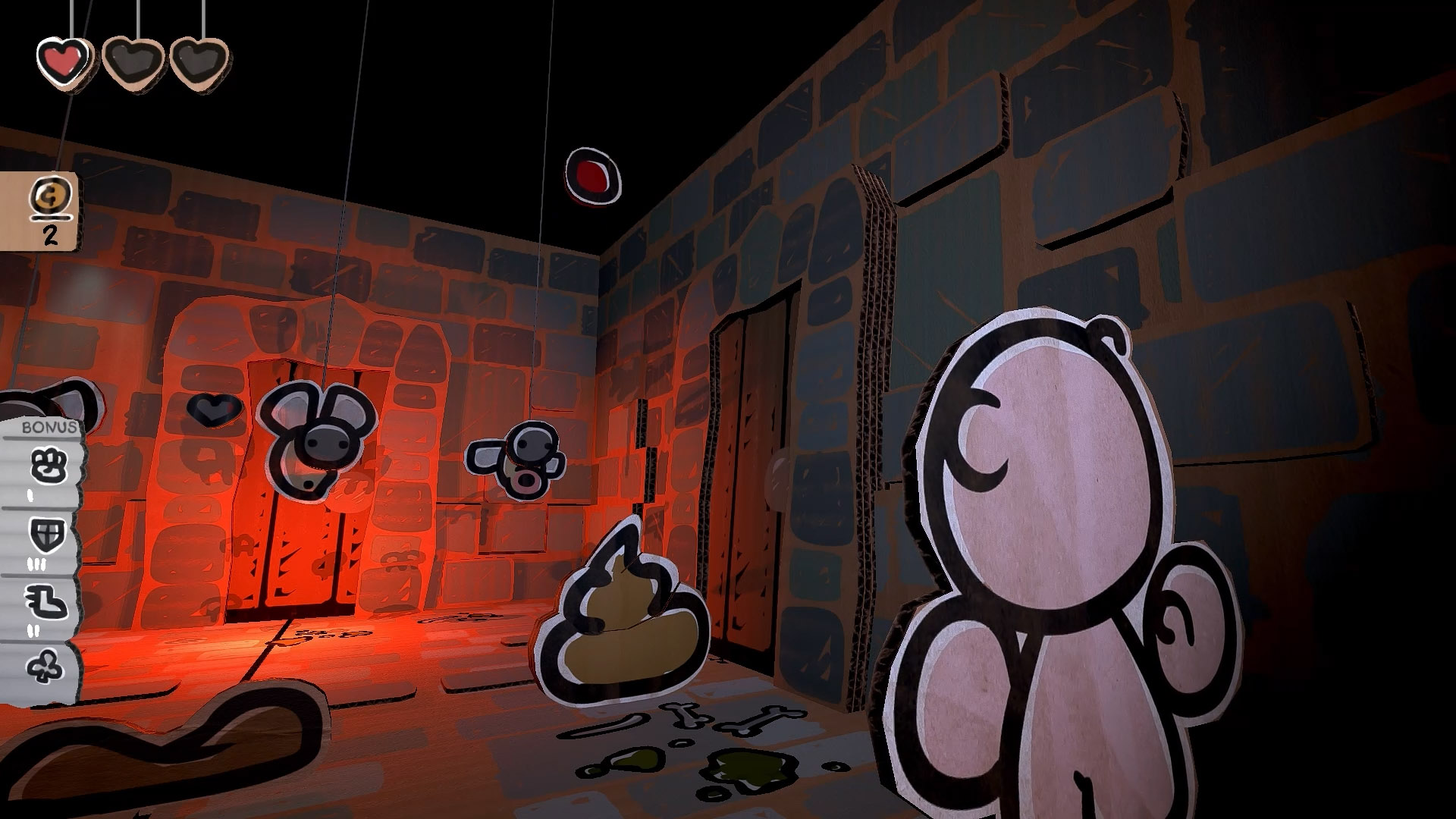The Legend of Bum-bo is a strange dungeon crawling puzzler, but it's still an Edmund McMillen game
The prequel to Binding of Isaac is clever and unmistakably McMillen, despite the new genre.
The Legend of Bum-bo is not an easy game to explain. Broadly speaking, it's a first-person dungeon-crawler with a turn-based battle system built atop a match-four puzzle game, but even that feels reductive in how it glosses over just how much poo and snot is involved (it's a lot). The upcoming project from The Binding Of Isaac co-creator Edmund McMillen might be simultaneously his strangest and most familiar game to date (poo and snot, after all, are McMillen hallmarks).
Little flourishes add to the feeling of a kid's puppet show: stains on the floor and walls from attacks, fallen enemies literally tearing apart when defeated
The basics: players pick one of four characters, each offering different skills and items, before setting out on a four-chapter quest that'll see them traverse four dungeons, each containing two bosses. The explicit plot is about retrieving some gold, but as I expected from McMillen, and what he was keen to remind me of during the guided demo, is that there's a lot more under the surface for those who go searching.
Bum-bo is a Binding of Isaac prequel, and the thematic links are immediate. A music box rendition of Genesis, the song Isaac's mother sings to him, plays over the intro screen. Isaac's bubbly-but-grungy aesthetic is still here. But there's also an almost defiant undercurrent to how Bum-bo rejects the quick-fire chaos of Isaac in favour of quiet calculation. The whole process is much slower, having players move room-to-room with a set of arrow-keys at the bottom of the screen, like the point-and-click RPGs of old. Each room will hold either some treasure, an enemy, or be empty—or possibly an item-selling NPC. If it's an enemy, players are stuck and must engage in battle, and if not they can come and go as they please.

Bum-bo makes the jump from 2D to 3D, but in a roundabout way. The rooms are essentially cardboard boxes, with everything else being cardboard inserts that create a layered diorama. Like a lo-fi Paper Mario, everything is its own 2D image animated on a card, and every interaction has these pieces move and connect as if being controlled by a puppeteer. McMillen points out that when he was a kid, making dioramas was one of his main sources of entertainment, and making a game that evoked that kind of DIY fantasy was important to him.
The overall construction, headed up by lead designer James Id, is clever and intricate. A dynamic camera zooms in for various special moves and big moments, hanging back to create the UI when it's the player's turn. Little flourishes add to the feeling of a kid's puppet show: stains on the floor and walls from attacks, fallen enemies literally tearing apart when defeated, and the health bar being little hearts that sway as they hang from the top of the screen on string.
For Isaac diehards, the battle system is going to be the point of contention. This isn't an action game. It's not made to be done quickly, or even to play on the same muscles as Isaac or Super Meat Boy. Using a match-four mini-game, you've to gather mana of each of the five colours—brown (poop), green (snot), yellow (urine), red (heart) and white (bone)—to do your moves. Each of these also have a corresponding ability: matching hearts replenishes health, matching snots creates a booger that can be thrown at an enemy, and so on.
Every character comes with certain attacks and spells that require different colour combinations, some doing simple damage, some doing damage and having an after-effect, while more abilities and items can be earned and bought later. Each turn, you start with a certain number of movements that you must split between the mini-game to generate mana and attacking with whatever you have the necessary bodily substances for.
Keep up to date with the most important stories and the best deals, as picked by the PC Gamer team.

Enemies come either flying or on the ground, and each dungeon will have its own particular nasties. Their attack area is composed of a front row and a back row split into three columns, and the front row must be completely destroyed before attacking the back. Some foes can exist in both rows by losing their head, which creates a headless creature in the back. A warning flashes up that they're readying a bite or a projectile or what have you, allowing players to focus their offensive on immediate threats while gathering storage for more elaborate moves. A luck meter increases chances of critical hits and dodging, and hearts can be replenished in battle as well as through scouring for treasure.
It's an intuitive system that's more reserved than Isaac, but still manages to retain some of that chaotic strategy. As I'm questioning the flow of battle, Edmund laughingly tells me the whole thing is probably just a sign he's playing too much Magic: The Gathering. Watching it in motion, it certainly feels like the kind of game those of us who spent our lunch-breaks in school playing Magic would then go home to spend hours playing.
The demo I saw was a portion of an obviously incomplete game. While the actual exploring was cohesive, the between-levels casino, where players can gamble for supplies and new items, was missing background art, the NPCs sitting in a large black void. But what's there is already oozing with that magic fans of Isaac have to expect. At the end of the demonstration, Edmund is defeated by the first boss, a giant poop monster (what else?). He discusses his worries that some may not like Bum-bo because of how different it is. Only time will tell on that, but what I saw was most definitely an Edmund McMillen game.

